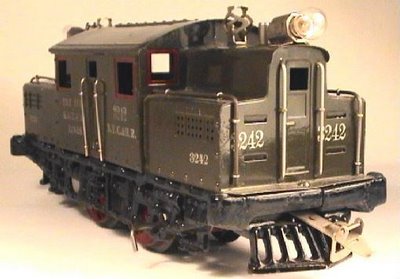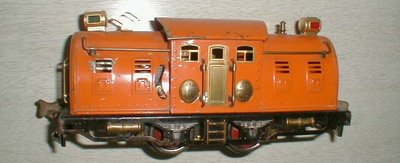 Underside of Lionel No.4 showing one of the two cast iron weights. Its likely that the weights were designed to add traction. A similar weight is affixed to the opposite end of the locomotive. I have also seen these weights mounted over the frame inside the cab.
Underside of Lionel No.4 showing one of the two cast iron weights. Its likely that the weights were designed to add traction. A similar weight is affixed to the opposite end of the locomotive. I have also seen these weights mounted over the frame inside the cab.Saturday, April 15, 2006
 Underside of Lionel No.4 showing one of the two cast iron weights. Its likely that the weights were designed to add traction. A similar weight is affixed to the opposite end of the locomotive. I have also seen these weights mounted over the frame inside the cab.
Underside of Lionel No.4 showing one of the two cast iron weights. Its likely that the weights were designed to add traction. A similar weight is affixed to the opposite end of the locomotive. I have also seen these weights mounted over the frame inside the cab.Friday, April 14, 2006
 Lionel No. 4U Outfit.
Lionel No. 4U Outfit.Unassembled O-Gauge No.4 Bild-A-Loco locomotive. Assembled and decorated locomotive cab and frame, motor parts, wheels, drive gears arranged on a metal tray and circle of track.
The black enameled motor base permits the locomotive motor to be converted to a stationary motor. The axles and flanged wheels nay be exchanged with a flywheel-pulley shaft or a capstan-sprocket shaft. The stationary motor drive shafts are visible to the left and right of the brass locomotive collector shoe assembly. The stationary motor is known as the Bild-a-Motor.
The No. 4U is only 4U while in the box. When assembled it becomes a No.4 An example of a piece that must have the box. This outfit appears to be missing the screw driver and include an extra flywheel pully shaft.
Saturday, November 12, 2005
Friday, November 11, 2005

The Lionel No. 256 with cab removed to expose dual reverse switches and connecting linkage. The two screw heads to the left and right of the reverse switches are the pivot points for the twin motors.
One thing missing in the design of this locomotive is space for the Lionel reverse unit. Without the "E Unit" distant reverse unit that was featured in mid level and premium locomotives, the 256 was at a disadvantage and had to give up its position as top of the line locomotive. The 256 was the only O-gauge twin motor locomotive in this period.


Lionel No.4 in yellow. A color that often known as orange is called, in this instance, yellow by the Lionel Corporation. This month I will concentrate on pre-World War II production items in orange. This locomotive was also produced in grey. The No.4 Bild-a-Loco features a manual reverse motor designed to be easily disassembled with a screw driver. The locomotive was also produced as the No. 4U. The No. 4U consisted of the unassembled locomotive and track.











